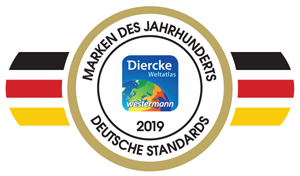British Isles - Political map
Orientation
978-3-14-100890-6 | Page 83 | Ill. 2

Overview
The British Isles are a group of islands in the North Atlantic Ocean consisting of the islands Great Britain, Ireland, the Isle of Man, the Hebrides, and over 6,000 other smaller islands. Located in the north-west of continental Europe they represent an area of around 315,000 square kilometres, offering a modest topography with Ben Nevis being the highest elevation (1,345m) and Lough Neagh the biggest lake (390m2). The climate is mild and humid due to the influence of the North Atlantic Drift, bringing a lot of moisture and rising temperatures by 11°C. This results in a lack of temperature extremes.
Twi large islands, two countries
The term British Isles, however, is a controversial one, not being officially recognised by the government of Ireland. Ireland offers an alternative option.
The two sovereign countries of the British Isles are the Republic of Ireland and the United Kingdom of Great Britain and Northern Ireland. The name of the latter was formally adopted in 1927, after a series of changes. In 1707 the Kingdom of England (including Wales, annexed in 1542) and the Kingdom of Scotland formed the United Kingdom of Great Britain under the Treaty of Union. In 1801 the Kingdom of Ireland joined the union creating the United Kingdom of Great Britain and Ireland until finally most of Ireland seceded from it in 1922, creating the Irish free state, before it was officially declared a republic in 1949.
Since then, the United Kingdom of Great Britain and Northern Ireland has faced some domestic challenges. Already in the 19th century, Scotland first started political campaigns for being granted self-government. They officially achieved that in 1999. Later the strive for independence from the UK became a major focus. Even though the 2014 Scottish independence referendum’s outcome was to stay in the union, a second one has been proposed after the UK decided to leave the European Union. This so-called Brexit has probably been the greatest challenge to the union since deciding to leave. Not only is Scotland ready for another referendum, but also changing trade agreements between the UK and the EU due to the Brexit cause new tensions. Especially the Northern Ireland Protocol has been controversially discussed. It helps prevent checks at the land border between the Republic of Ireland and Northern Ireland to protect the 1998 Northern Ireland peace deal (Good Friday Agreement) and to not install a secured border again. This means, however, that certain goods imported from the UK into EU territory will also be declined for Northern Ireland.
Political tensions within the countries and the sovereign states of the British Isles have always existed, apart from disagreements with other states and unions. Only future can tell how these disagreements will be tackled and discussed.
Author:
Ronny Birnstein




